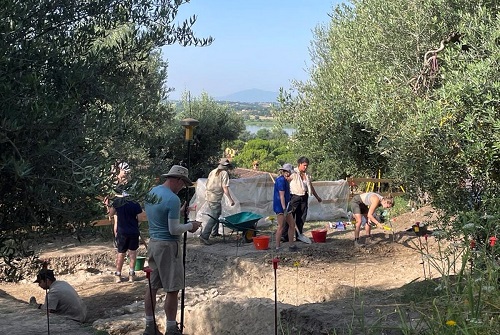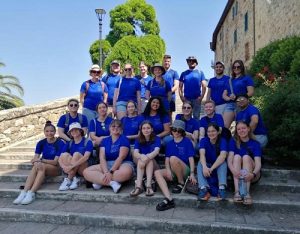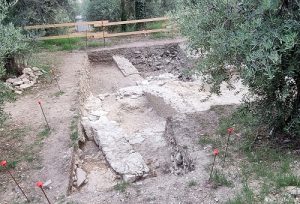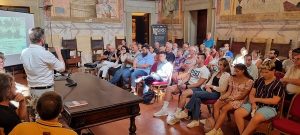Unveiling the Roman Treasures of the Past: The Umbra Institute’s Summer 2023 Archaeological Discoveries

Each summer, the Umbra Institute’s archaeological school program brings together aspiring archaeologists from around the world, offering a unique opportunity to unearth ancient treasures, unravel historical mysteries, and delve into the rich tapestry of Italian heritage.
This summer’s 2023 session of archaeological excavations linked to the Trasimeno Regional Archaeological Project has just ended. The TRAP project was born out of the well-established and long-standing collaboration between the Municipality of Castiglione del Lago, the Acqua Association, and the Umbra Institute and this year it has undoubtedly borne significant and surprising results.
Under the scientific direction of esteemed professors Rebecca Schindler and Pedar Foss, (DePauw University) and supported by archaeologists Stefano Spiganti, Giampiero Bevagna, and Giancarlo Santarelli, a team of 22 young archaeologists, alongside members of the Acqua Association, carried out for almost a month an excavation on a hill of Castiglione del Lago, leading up to Via Belvedere.
Archaeologists had previously speculated the existence of traces from an ancient era beneath the ground of Poggio di Castiglione but now there’s finally scientific confirmation as well.
The campaign brought to light, on three terraces of the hill, Roman walls, a large water channel, and a yet-to-be-deciphered support structure that could be part of an Early Imperial Roman villa, a fountain, or a thermal complex. These uncovered ancient structures are thought to originate from the Early Imperial Roman period, specifically dating back to the 1st and 2nd century AD. The hydraulic channel mentioned earlier was investigated along an 8-meter length so far.
On the highest terrace of the hill, archaeologists unearthed an even more ancient structure. It appears to be either a road or a significantly large courtyard, potentially of Etruscan origin, dating back to approximately the 2nd century BC.
 The prevailing hypothesis, as excavation supervisor and archeologist Rebecca Schindler suggests, is that certain structures served an agricultural purpose. This is supported by the discovery of remnants of large containers commonly used for the storage of various local products, including food, and perhaps even from the Trasimeno Lake.
The prevailing hypothesis, as excavation supervisor and archeologist Rebecca Schindler suggests, is that certain structures served an agricultural purpose. This is supported by the discovery of remnants of large containers commonly used for the storage of various local products, including food, and perhaps even from the Trasimeno Lake.
Giampiero Bevagna, archaeologist, and history professor at The Umbra Institute, stated: This year’s excavation has been highly successful, making it incredibly intriguing to continue unraveling the ancient history of Castiglione del Lago.”
 The students and researchers involved in these archaeological findings gained significant recognition by being featured in TV reports (RAI, TG Umbria), in prominent local newspapers such as the renowned Corriere dell’Umbria, and on web news platforms like Perugia Today. Most notably, they had the opportunity to participate in a conference held on July 6th at Palazzo della Corgna in Castiglione.
The students and researchers involved in these archaeological findings gained significant recognition by being featured in TV reports (RAI, TG Umbria), in prominent local newspapers such as the renowned Corriere dell’Umbria, and on web news platforms like Perugia Today. Most notably, they had the opportunity to participate in a conference held on July 6th at Palazzo della Corgna in Castiglione.
Paola Romi, from the Superintendency of the Archaeological Heritage of Umbria, was there and affirmed: “I believe we are at a turning point in our understanding of Poggio di Castiglione. The recently uncovered structures exhibit remarkable preservation in terms of their materials, including their size, shape, and overall condition. This bodes well for the possibility of future development, where the excavation site could potentially transform into an archaeological site open for public visitation.”
While awaiting the resumption of excavation activities next year, in order to further investigate and confirm hypotheses and dating of the discovered structures, city mayor Matteo Burico states: “Through our partnerships with local associations such as the Archeo Club and schools like [DePauw University] and The Umbra Institute, we have established that this area holds significant potential for uncovering remarkable discoveries that enhance our understanding of the past. Moreover, these findings serve as a strong foundation for future marketing initiatives aimed at promoting our region.”
Stefano Spiganti, archaeologist and supervisor on the excavation site, has stated: “Undoubtedly, this recent discovery stands out as one of the most significant findings in the entire Umbria region. It holds immense potential for advancing both the protection and development of archaeological sites in the area.”
For an in-depth look at Umbra’s archeology field school, listen to the podcast episode featuring archeology students sharing their experiences with the program and excavation field work and don’t forget to check our website too.